Menus
- A comparison of mid-range naked bikes
- Yamaha MT-09
- Aim at the curve, give the steering impulse, fold down, done
- Kawasaki Z 800
- Enormous tendency to stop when braking sharply
- BMW F 800 R.
- The BMW cuts a fine figure on winding roads
- Technical specifications
- Readings
- Test result
- 1. BMW F 800 R
- 2. Yamaha MT-09
- 3. Kawasaki Z 800
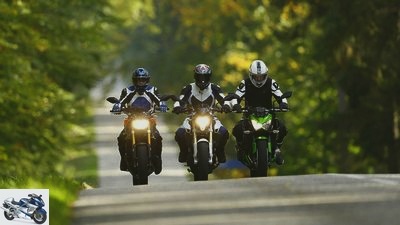
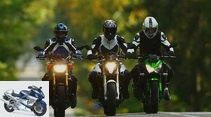
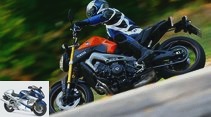

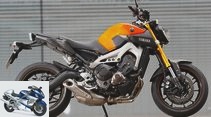
35 photos
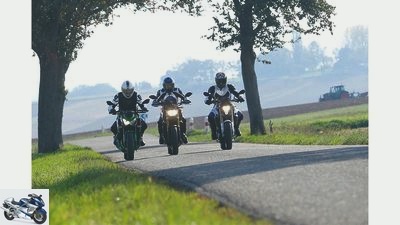
1/35
The center is no longer where it used to be. Because bikes with displacements around 800 cm³ are now only part of the middle class. The comparison test proves that they play in the top league when it comes to driving fun.
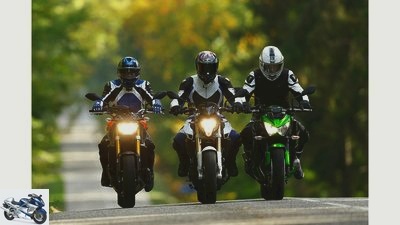
2/35
Versatile the BMW F 800 R, uncompromising the Kawasaki Z 800. We come to the Yamaha MT-09.
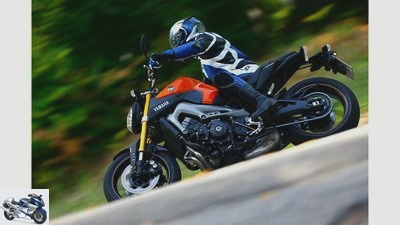
3/35
The Yamaha MT-09 can be described most simply and aptly as: three-cylinder. It is and still will be a great bike.

4/35
Yamaha MT-09.
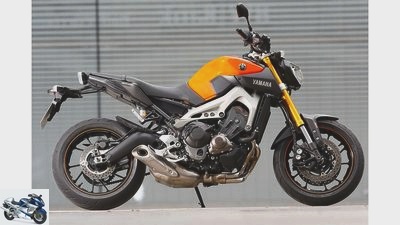
5/35
The Yamaha MT-09 follows the current trend of the short stub tail. Too bad that the license plate has to go somewhere.
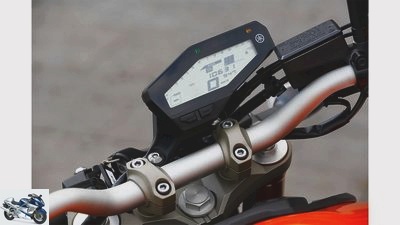
6/35
This cockpit is not pure eye candy either, but it is not stingy with information including the outside temperature.
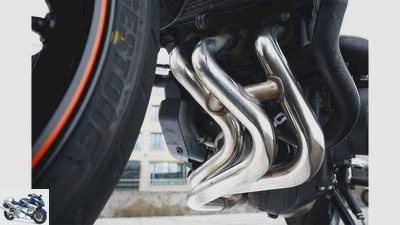
7/35
All crooked things are definitely three in this case, because the Yamaha Triple is still a very big hit.
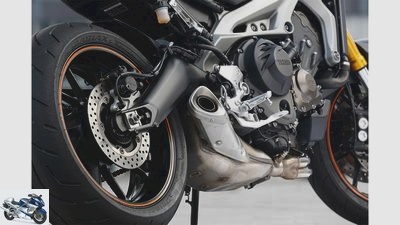
8/35
Crowds, focus! That’s why the compact exhaust hardly dares to emerge from behind the oil pan.
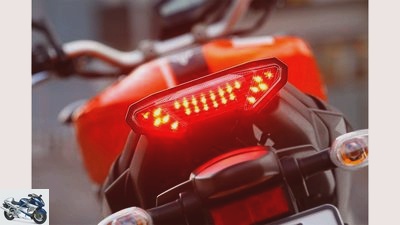
9/35
The rear is not good for anything more than holding the taillight and license plate holder. Luggage attachment nil.
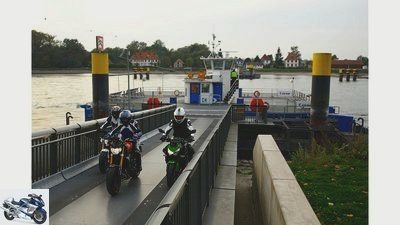
10/35
The middle graders go through a lot, but at some point it’s over. They cannot swim.
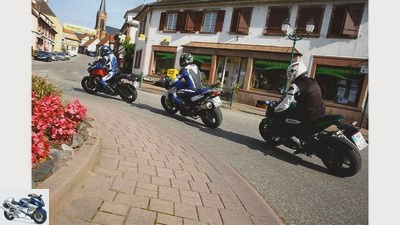
11/35
Kawasaki Z 800, Yamaha MT-09 and BMW F 800 R in the test.
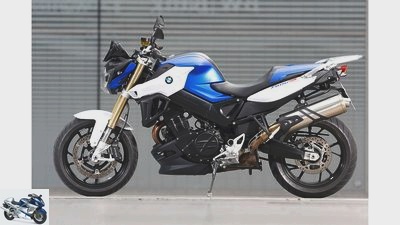
12/35
BMW F 800 R..
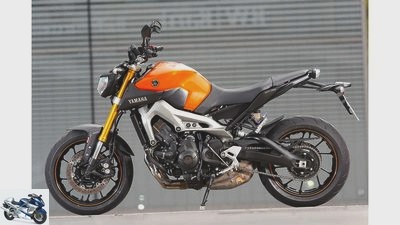
13/35
Yamaha MT-09.
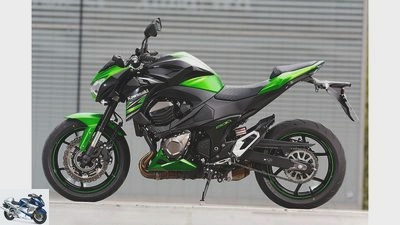
14/35
Kawasaki Z 800.
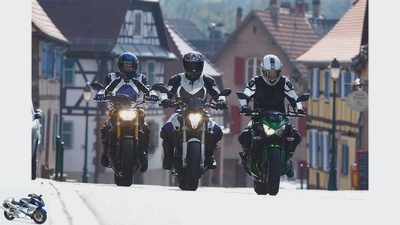
15/35
Look me in the eyes, little one: Even without a disguise, individual faces can be shaped.

16/35
Power on the crankshaft. Measurements on the Dynojet roller test stand 250, corrected according to 95/1 / EG, maximum possible deviation ± 5%.
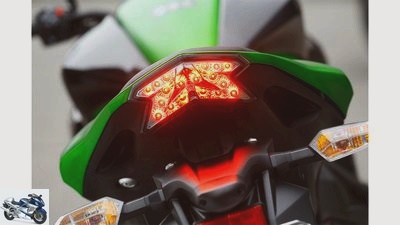
17/35
Styled from front to back. This even applies to the zett-shaped diode rear light. Also in the picture: the pillion passenger recess.
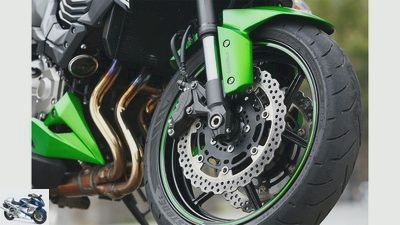
18/35
Factory tune-up? Since Dunlop could not deliver original tires, the test Kawa came with Bridgestones. MOTORRAD rated the original condition.
Measured against the wild habitus of the Kawa, the front brake works quite bluntly, and it tends to stoppies.
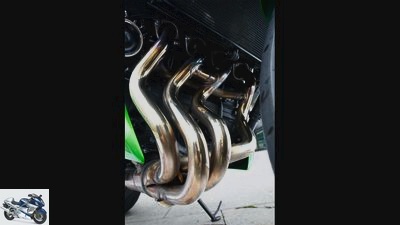
19/35
Wild elbow winding. The long tubes should improve the torque curve. But only works to a limited extent.
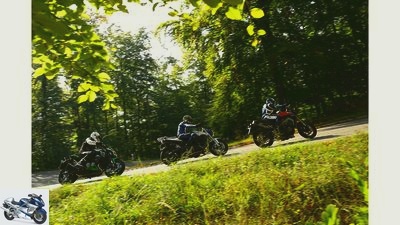
20/35
In the comparison test, the BMW F 800 R, Kawasaki Z 800 and Yamaha MT-09 compete against each other.
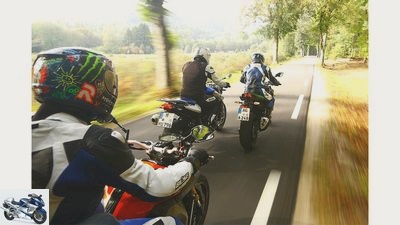
21/35
Not only, but also on small streets with little traffic, the medium bikes provide a maximum of riding pleasure.
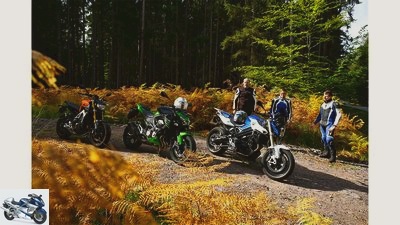
22/35
Our three candidates can each be aptly described with their own term.
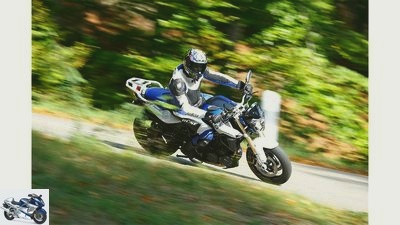
23/35
Versatility. Strolling or shooting, the BMW F 800 R offers both.
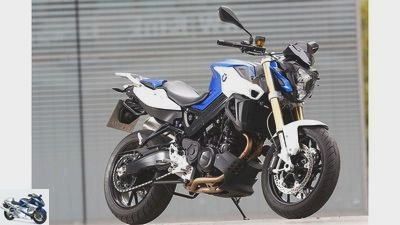
24/35
BMW F 800.
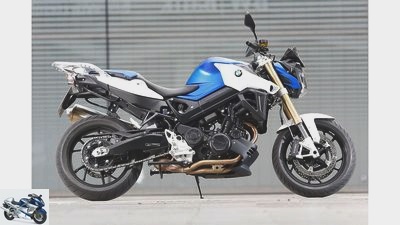
25/35
The BMW F 800 R is the “form follows function” principle. Nevertheless, it can be seen particularly well in white and blue.
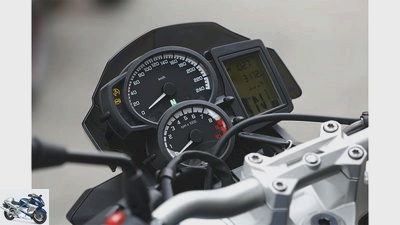
26/35
In the past, this cockpit would have been called matter-of-factly. Today the traditionalist is happy about the analogue displays.
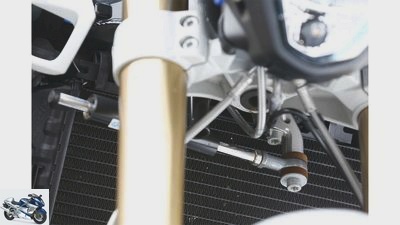
27/35
The steering damper is good against kickback, but ensures wobbly handling at low temperatures.
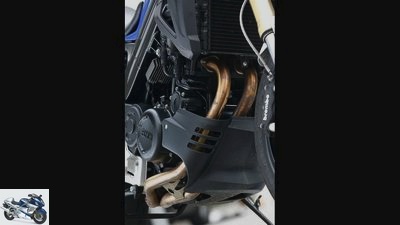
28/35
The two stainless steel elbows are shamefully hidden behind the large, surcharge front spoiler.

29/35
Nice back against bills: LED indicators and taillights as well as the aluminum luggage rack cost extra.

30/35
The BMW F 800 R is therefore versatile. What about the Kawasaki Z 800? We describe them with …
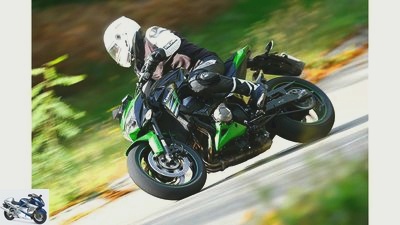
31/35
Uncompromising. You love them or you hate them. Yes or no.
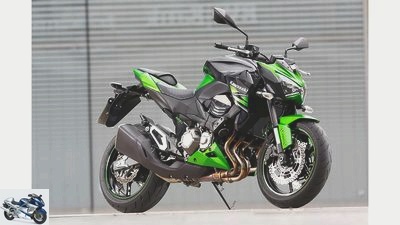
32/35
Kawasaki Z 800.

33/35
If there’s one thing you can’t blame the Kawasaki Z 800 for, it’s arbitrariness. This is design for design’s sake.
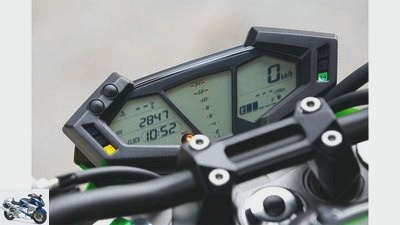
34/35
Awesome command center. Good readability was not at the top of the specifications. Wild look rather.
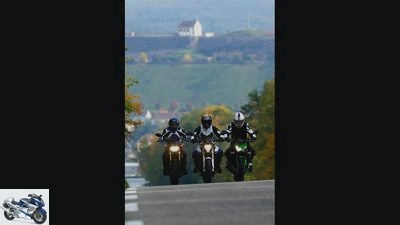
35/35
Today we leave the church in the village and the chapel in the citadel. Earthly grip instead of divine assistance.
Finally, it should be noted that despite all the differences that separate the three bikes from one another, they have one thing in common: They are anything but mediocre.
Kawasaki Z 800, Yamaha MT-09 and BMW F 800 R
A comparison of mid-range naked bikes
The golden mean is no longer what it used to be. Because bikes with displacements below 800 cm³ are mid-range today, but in terms of driving fun they are in the top league. We test Kawasaki Z 800, Yamaha MT-09 and BMW F 800 R..
The word middle class always sounds a bit like mediocrity. But if the top of two-wheeler development is currently leveling off at around 200 hp engine power, then it is clear that Schmalhan’s chef is not in the midfield either, but here too you are faced with well-stocked meat pots. In the case of the BMW F 800 R there are two, in the case of the Yamaha MT-09 three, and the Kawasaki Z 800 even offers four ways to dip the trowel. In purely metaphorical terms.
Buy complete article
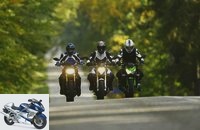
Kawasaki Z 800, Yamaha MT-09 and BMW F 800 R
A comparison of mid-range naked bikes
Yamaha MT-09. After all, it was the brave MT-09 with which Yamaha in 2013 catapulted itself out of the depths of the registration statistics and right into the heart of two-wheeler fans with a bang.
Yamaha MT-09
The Yamaha MT-09 is a good companion for an intensive two-wheeler relationship
The fun starts when you sit up. Sitting behind the high and wide handlebars is quite upright, with little weight on your wrists. In addition, there is the narrow tank, which allows a full knee grip. The feet find their feet as if by themselves, but the knee angle is quite sporty. The three-cylinder of the Yamaha MT-09 starts immediately. Now quickly set the mapping to “B” via the handlebar switch, and off you go. Both in standard and even more so in “A” mode, the throttle response is quite rough, which can be annoying when you drive normally. Even from idle speed there is a lot of thrust, at around 5500 there is a second wind, whereby the typical triple growl changes into an aggressive tone.
On the test motorcycle, the switch box was quite gritty and wanted to be operated with the right mix of care and force. Thanks to the ample torque curve, it doesn’t have to be used too often. The basic set-up of the relatively soft suspension of the Yamaha MT-09 fits the vast majority of everyday situations. The spring base and rebound stage are adjustable for the fork and shock absorber. Only when there is a lot of pressure on a bad track does the fork reach its limits and sometimes block while the shock absorber stoically swallows the bumps. Under these circumstances, braking in the ABS area should also be used with caution. Long control intervals and the sometimes surprising release of the brakes then make eyes wide under the helmet. In return, the rear wheel stays where it belongs: on the ground.
Aim at the curve, give the steering impulse, fold down, done
Moving in a somewhat quieter course, the Yamaha MT-09 with Bridgestone S20 special specification “M” tires not only pleases with its high level of comfort, but also with its largely neutral handling. Aim at the curve, give the steering impulse, fold down, done. It can go on like this for hours. Moved sparingly, the Yamaha only takes 4.3 liters per 100 kilometers, with a lot of driving pleasure it is a good liter more, so you should look for a gas tank after around 250 kilometers.
In everyday life, long service intervals help keep maintenance costs within reasonable limits. Unfortunately, the stylish, short rear ensures that the driver is also sucked in from behind when it rains, and it also quite successfully prevents luggage from being attached. Nevertheless, the Yamaha MT-09 is a good companion for an intensive two-wheeler relationship. From January to August 2015, almost 2,100 customers said yes.
Kawasaki Z 800
The Kawasaki Z 800 is a polarizing bike.
That, right from the start, basically also applies to the Kawasaki Z 800. However, and this becomes clear from the first approach, she does not want to be everybody’s darling. Opinions already differ when it comes to the design. If you like the kawa, you can buy it. If you don’t like it, you won’t buy it, even if it got all 1000 points in the MOTORRAD rating. But the Zett is far from that. As soon as you get on, it becomes clear that a different, sportier wind is blowing here than on the Yamaha MT-09.
The handlebars are positioned further forward and lower, which results in a more active, albeit not uncomfortable, sitting position. However, despite almost the same (820 to 810 mm) seat height as on the Yamaha, one has the feeling of sitting more “on” than “in” the motorcycle. The also fully digital cockpit shines less with good readability than with a wild look. Above all, the centrally located bar tachometer can hardly be read in sunlight. This is a shame because the low-vibration row quad is most likely to depend on it. Not that the Kawasaki Z 800 is not drivable below, but in direct comparison with the two opponents, the drive looks quite anemic up to just under 7000. He then shows his second face over it and quickly approaches the red area with wild roars. So in order to stay tuned in the Winkelwerk on the BMW F 800 R and the Yamaha MT-09, the Kawa has to be kept constantly in the power range, which is not a real problem given the best gearbox.
Enormous tendency to stop when braking sharply
Moved in this way at a straight gallop, around 6.5 liters run through the injection nozzles, with a leisurely trot 5.0 liters are sufficient for the same distance. In gallop mode, it is also noticeable that the approved Bridgestone S20 Evo tires mounted on the test machine harmonize much better with the Kawasaki Z 800; the sluggish turn-in that was criticized with the original Dunlop D214 and the high righting moment when braking in an inclined position have largely disappeared. Since MOTORRAD always rates the test machines in series production, these improvements are not reflected in the points assessment shown.
The enormous tendency to stop when braking sharply on the test machine is independent of the tires. The front had to be opened more than once during the brake tests to prevent a rollover. This should urgently be improved. Also, the rear strut is most likely to come to an end on bad roads. The machine then wedges what lifts the rider out of the saddle time and time again. Under the same conditions, the two colleagues have more reserves. And although, or perhaps precisely because the Kawasaki Z 800 is a polarizing bike, it was able to inspire almost 1,700 bikers in the first eight months of 2015.
BMW F 800 R.
The BMW F 800 R has been on the market since 2009.
The only thing left is the BMW F 800 R. This trio is the Methuselah because it has been on the market since 2009. This may explain that, despite the model update that took place this year with an upside-down fork, new headlights, a different handlebar and some fine-tuning on the engine, which now produces 90 instead of the previous 87 hp, in the same period as the other two ” only “was able to convince just under 1000 customers. Or maybe it’s the price, because the test motorcycle, equipped with various accessory packages, is by far the most expensive at 10,460 euros. In addition, she always seems a bit nerdy in this environment. Do you have cold fingers? I have heated grips. Do you want to transport something? I have porters. Do you want to lubricate the chain? I have a main stand. The list goes on.
What really bothers about the BMW F 800 R equipped with the standard seat is the very narrow knee angle. Together with the flat cranked, far back and low handlebars, the result is a fairly passive sitting position. At least the seating problem can be solved, BMW has four different heights of benches in its range, some of which are at an additional cost. Apart from that, the BMW is easy to live with. Off the highway, the lack of performance hardly comes into play, especially since the curves of up to 6000 tours are close together. Thanks to the compensating connecting rod, the fast-turning synchronous rotor largely retains vibrations. Only on top it gets annoying.
The BMW cuts a fine figure on winding roads
The BMW F 800 R with Metzeler Roadtec Z8 tires cuts a fine figure, easy to steer and neutrally circles the curves. The combination of non-adjustable fork and ESA light can hardly be disturbed. The ESA only adjusts the rebound stage of the shock absorber at the push of a button; the spring preload can be adjusted using the handwheel.
And should your loved one feel the need to go on tour, the BMW F 800 R offers by far the most comfortable rear bench. All in all, she collects the most diligent points and leaves the two Japanese women behind, at least in the MOTORRAD best list. Finally, it should be noted that despite all the differences that separate the three bikes from one another, they have one thing in common: They are anything but mediocre.
Technical specifications
BMW F 800 R, Kawasaki Z 800 and Yamaha MT-09.
Readings
Power on the crankshaft. Measurements on the Dynojet roller test stand 250, corrected according to 95/1 / EG, maximum possible deviation ± 5%
On this side of the full throttle position and in everyday use, the lower power of the BMW F 800 R is hardly noticeable, the torque drop at 4000 rpm is more likely. The Yamaha MT-09 already starts at a high level, at 5000 rpm there is a second, fresh wind. However, the triple only turns off properly in fourth gear, in fifth it ends at around 10,000 rpm, in sixth at almost 9000 rpm, corresponding to 210 km / h.
The Kawasaki Z 800 is always allowed to turn whatever works, and it needs it too. Because the four-cylinder typical bottom-little and top-a lot characteristic is more pronounced in practice than visible on the diagram. Below 7000 rpm, the Kawa gives the good Dr. Jekyll, this turns her into the poisonous Mr. Hyde. Fun for those who like it.
Test result
Briefly agree on the driving impressions, then the points are awarded.
1. BMW F 800 R
BMW F 800 R..
1st place: BMW F 800 R – 665 points
In the end, the BMW F 800 R is once again at the top. It hardly affords any weaknesses, and its strengths are further expanded by the dynamic, tour and safety packages that are subject to a surcharge.
2. Yamaha MT-09
Yamaha MT-09.
2nd place: Yamaha MT-09 – 647 points
The Yamaha MT-09 is a motorcycle in the literal sense of the word. The fantastic three of a kind is still a stunner. If only one could optimize the mapping now. And tightened the chassis a bit. Otherwise there are no serious points of criticism.
3. Kawasaki Z 800
Kawasaki Z 800.
3rd place: Kawasaki Z 800 – 624 points
How it is with the extremists. When consensus is required, it is easy to be left behind. Despite slight weaknesses in the engine and ABS coordination, the Kawasaki Z 800 is an inspiring motorcycle.
Related articles
-
Comparison test Suzuki SV 650, Honda CB 650 F, Kawasaki ER-6n, Yamaha MT-07
www.bilski-fotografie.de 34 pictures www.bilski-fotografie.de 1/34 They are the hottest candidates among the middle class naked bikes ….
-
Comparison test Honda CBR 500 R, Kawasaki Ninja 400, KTM RC 390, Yamaha YZF-R3
r-photography.info 29 pictures r-photography.info 1/29 Honda CBR 500 R, Kawasaki Ninja 400, KTM RC 390 and Yamaha YZF-R3 in comparison test ….
-
Yamaha MT-07, Kawasaki Z 650 and Suzuki SV 650 in the test
r-photography.info 25 images r-photography.info 1/25 The season is just around the corner, the drill sergeant calls for roll call. With less than 200 kilograms …
-
Kawasaki Z 300, KTM 390 Duke and Yamaha MT-03 in the test
www.bilski-fotografie.de 27 photos www.bilski-fotografie.de 1/27 Picture gallery: Entry-level naked bikes Yamaha MT-03 (left), KTM 390 Duke and Kawasaki…
-
fact Concept comparison Honda CBR 1100 XX Kawasaki ZX-12 R Suzuki GSX-R 1000 Suzuki GSX 1400 Yamaha FZS 1000 Fazer Yamaha FJR 1300 Six bombs The six …
-
BMW R 1200 RS and Kawasaki Z 1000 SX in a comparison test
r-photography.info 18th photos r-photography.info 1/18 BMW R 1200 RS and Kawasaki Z 1000 SX. r-photography.info 2/18 BMW R 1200 RS and Kawasaki Z 1000…
-
Middle class naked bikes in comparison test
r-photography.info 30 pictures r-photography.info 1/30 With the Z 900 Kawasaki pushes the middle class close to the full liter. Looks up …
-
Comparison test Honda VFR 800 F, Kawasaki Z 1000 SX and BMW R 1200 RS
fact 32 pictures fact 1/32 The Honda VFR 800 F looks small and compact, but carries a lot of weight with it: 245 kg with a full tank. fact 2/32 The …
-
Ducati Hypermotard 939, Yamaha MT-09 and Aprilia Dorsoduro 900 in comparison test
Arturo Rivas Ducati Hypermotard 939, Yamaha MT-09 and Aprilia Dorsoduro 900 Funbikes in comparison test Now seriously: Have fun and reason …
-
Kawasaki Ninja 300, KTM RC 390, Honda CBR 300 R and Yamaha YZF-R3 in the test
markus-jahn.com 42 photos markus-jahn.com 1/42 Four bikes compete to compare the third-liter athletes. markus-jahn.com 2/42 The Honda fork also responds…